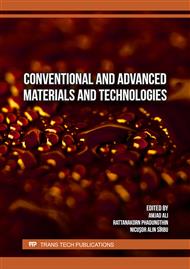[1]
M. Ren, X. Qian, Y. Chen, T. Wang, Y. Zhao, Potential lead toxicity and leakage issues on lead halide perovskite photovoltaics, J. Hazard. Mater. 426 (2022) 127848.
DOI: 10.1016/j.jhazmat.2021.127848
Google Scholar
[2]
P. Su, Y. Liu, J. Zhang, C. Chen, B. Yang, C. Zhang, X. Zhao, Pb-Based Perovskite Solar Cells and the Underlying Pollution behind Clean Energy: Dynamic Leaching of Toxic Substances from Discarded Perovskite Solar Cells, J. Phys. Chem. Lett. 11 (2020) 2812–2817.
DOI: 10.1021/acs.jpclett.0c00503
Google Scholar
[3]
G.J. May, A. Davidson, B. Monahov, Lead batteries for utility energy storage: A review, J. Energy Storage. 15 (2018) 145–157.
DOI: 10.1016/j.est.2017.11.008
Google Scholar
[4]
N. Vangapally, T.R. Penki, Y. Elias, S. Muduli, S. Maddukuri, S. Luski, D. Aurbach, S.K. Martha, Lead-acid batteries and lead–carbon hybrid systems: A review, J. Power Sources. 579 (2023) 233312.
DOI: 10.1016/j.jpowsour.2023.233312
Google Scholar
[5]
C. Lee, P. Chen, H. Ma, Direct and indirect lead-containing waste discharge in the electrical and electronic supply chain, Resources, Resour. Conserv. Recycl. 68 (2012) 29–35.
DOI: 10.1016/j.resconrec.2012.07.007
Google Scholar
[6]
R. Nag, E. Cummins, Human health risk assessment of lead (Pb) through the environmental-food pathway, Sci. Total Environ. 810 (2022) 151168.
DOI: 10.1016/j.scitotenv.2021.151168
Google Scholar
[7]
M.S. Collin, S.K. Venkatraman, N. Vijayakumar, V. Kanimozhi, S.M. Arbaaz, R.G.S. Stacey, J. Anusha, R. Choudhary, V. Lvov, G.I. Tovar, F. Senatov, S. Koppala, S. Swamiappan, Bioaccumulation of lead (Pb) and its effects on human: A review, J. Hazard. Mater.7 (2022) 100094.
DOI: 10.1016/j.hazadv.2022.100094
Google Scholar
[8]
Z. Xu, S. Gu, D. Rana, T. Matsuura, C.Q. Lan, Chemical precipitation enabled UF and MF filtration for lead removal, J. Water Proc.engineering. 41 (2021) 101987.
DOI: 10.1016/j.jwpe.2021.101987
Google Scholar
[9]
A. Lalmi, K.-E. Bouhidel, B. Sahraoui, C. el H. Anfif, Removal of lead from polluted waters using ion exchange resin with Ca(NO3)2 for elution, Hydrometallurgy. 178 (2018) 287–293.
DOI: 10.1016/j.hydromet.2018.05.009
Google Scholar
[10]
N. Abdullah, N. Yusof, L.W. Jye, J. Jaafar, N. Misdan, A.F. Ismail, Removal of lead(II) by nanofiltration-ranged thin film nanocomposite membrane incorporated UiO-66-NH2: Comparative removal performance between hydraulic-driven and osmotic-driven membrane process, J. Taiwan Inst. Chem. Eng. 128 (2021) 354–369.
DOI: 10.1016/j.jtice.2021.08.047
Google Scholar
[11]
R. Choumane, S. Peulon, Innovative electrochemical process for a total removal and/or separation of soluble heavy metals, J. Environ. Chem. Eng. 10 (2022) 108607.
DOI: 10.1016/j.jece.2022.108607
Google Scholar
[12]
A. Ghahremani, M. Manteghian, H. Kazemzadeh, Removing lead from aqueous solution by activated carbon nanoparticle impregnated on lightweight expanded clay aggregate, J. Environ. Chem. Eng. 9 (2021) 104478.
DOI: 10.1016/j.jece.2020.104478
Google Scholar
[13]
B. Sukkaneewat, S. Utara, Ultrasonic-assisted Dunlop method for natural rubber latex foam production: Effects of irradiation time on morphology and physico-mechanical properties of the foam, Ultrasonics Sonochemistry. 82 (2022) 105873.
DOI: 10.1016/j.ultsonch.2021.105873
Google Scholar
[14]
C. Hiranobe, G. Ribeiro, G. Barrera, E. Reis, F. Cabrera, A. Job, L. Paim, R. dos Santos, Cross-Linked Density Determination of Natural Rubber Compounds by Different Analytical Techniques, Mater. Res. 24 (2021).
DOI: 10.1590/1980-5373-mr-2021-0041
Google Scholar



